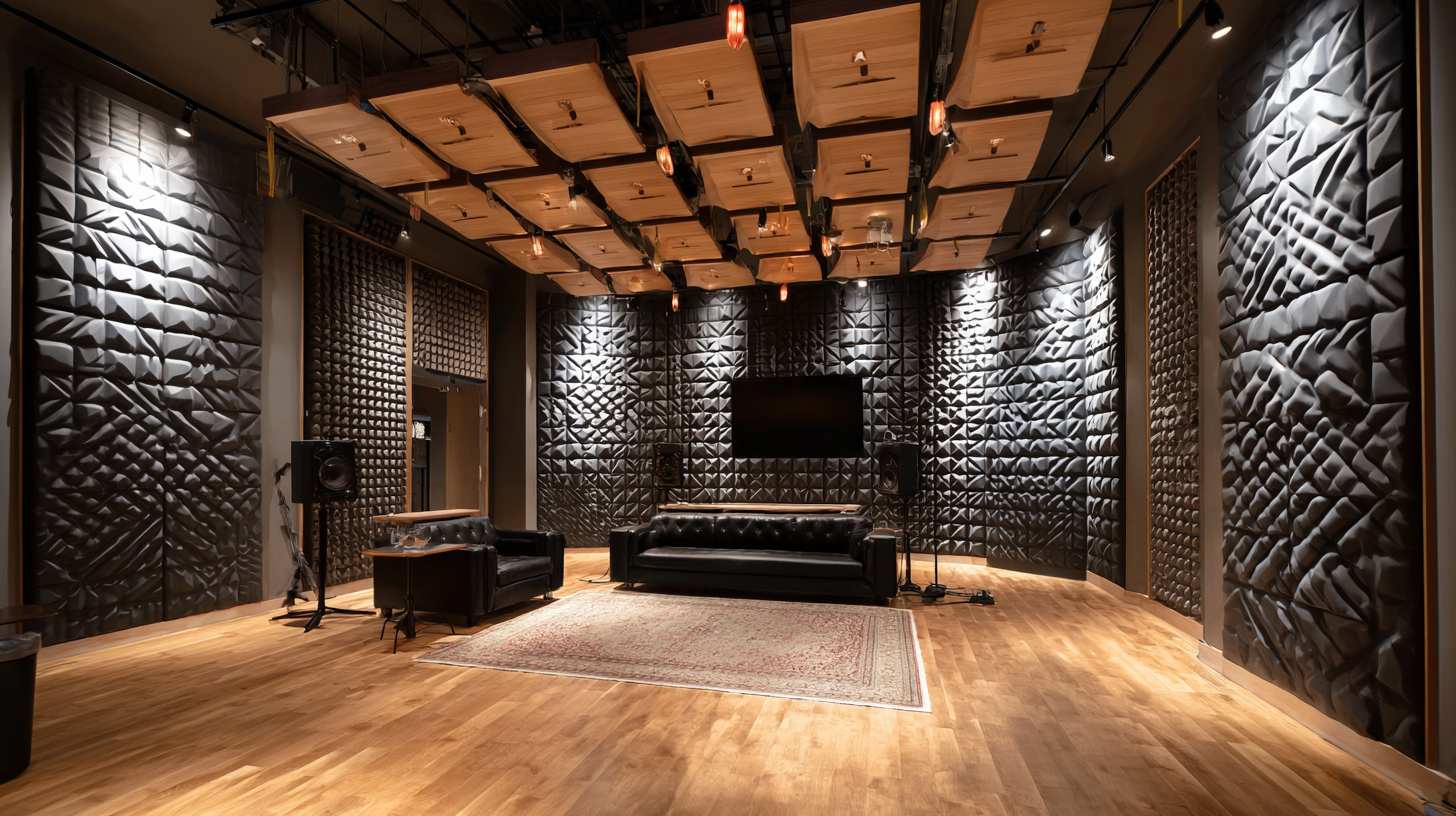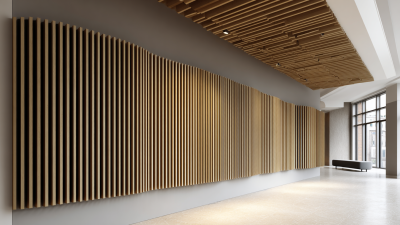Transform Your Space: The Science Behind Square Acoustic Panels and Sound Quality Enhancement
In recent years, the importance of acoustic treatment in interior spaces has gained significant attention, particularly for environments such as offices, recording studios, and home theaters. Square Acoustic Panels have emerged as a popular solution for enhancing sound quality, with a reported decrease in reverberation time by up to 50% when properly installed (Source: Acoustical Society of America). According to the National Institute of Acoustics, one-third of individuals cite poor acoustics as a major contributor to workplace distractions, impacting productivity by as much as 30%. By understanding the science behind these specialized panels, and their role in managing sound frequencies, users can effectively transform their space into a harmonious environment. This guide will explore the mechanisms through which Square Acoustic Panels operate and illustrate practical steps for optimizing sound quality in various settings.

Understanding the Basics of Sound Waves and Acoustics in Interior Spaces
Sound waves are a fundamental aspect of how we perceive and interact with our environment. When sound is produced, it travels in waves, oscillating through the air and interacting with various surfaces in a space. These waves can reflect, absorb, or scatter, depending on the materials present in the room. Hard surfaces, such as concrete or glass, tend to reflect sound, creating echoes and potentially disruptive noise levels. Conversely, softer surfaces can absorb sound waves, reducing reverberation and enhancing clarity.
In interior design, the strategic use of square acoustic panels serves to manipulate sound within a space. By placing these panels on walls or ceilings, we can control how sound waves behave. These panels are made from materials designed to absorb sound at specific frequencies, which helps in minimizing unwanted noise and improving overall sound quality. Understanding how sound waves interact with acoustics allows us to create spaces that not only look aesthetically pleasing but also provide an optimal auditory experience, whether for music, conversation, or relaxation.
The Role of Square Acoustic Panels in Reducing Echo and Noise Pollution
In modern architectural design, square acoustic panels play a crucial role in creating environments conducive to productivity and well-being by effectively reducing echo and noise pollution. According to the Acoustical Society of America, sound absorption materials can reduce ambient noise levels by as much as 10-15 decibels, significantly enhancing the auditory experience in spaces such as offices, classrooms, and concert halls. This reduction in noise not only improves clarity of communication but also contributes to a healthier workspace by minimizing stress associated with excessive background noise.

Moreover, the use of square acoustic panels has been shown to improve sound clarity and quality. A report from the National Institute of Standards and Technology indicates that poorly treated spaces can lead to sound reflections that diminish speech intelligibility, with studies revealing that 90% of participants in acoustic studies felt that well-designed panel installations foster greater engagement during meetings and presentations. By strategically placing these panels, users can mitigate unwanted reverberations and create a more inviting atmosphere, thereby enhancing overall productivity and comfort levels in any environment.
How Material Choice Affects the Sound Absorption Performance of Panels
The choice of materials in the construction of square acoustic panels significantly impacts their sound absorption performance. Various materials, such as fiberglass, foam, and wood, possess unique properties that affect their ability to mitigate sound waves. For instance, fiberglass panels are recognized for their high sound absorption capability across a wide frequency range due to their dense composition, which allows them to trap sound effectively. In contrast, while foam panels are lightweight and easier to install, their effectiveness largely depends on thickness and surface texture, making them more suitable for specific applications rather than general sound treatment.
Additionally, the surface finish of acoustic panels plays a crucial role in sound absorption. Panels with porous surfaces can disperse sound waves more efficiently, leading to reduced reverberation in a space. The combination of material density and surface texture directly correlates to how well the panel can absorb sound, making the selection process vital for achieving optimal acoustic quality. By understanding these material characteristics, individuals can better tailor their acoustic treatment strategies to meet their unique sound enhancement needs, transforming their spaces into more harmonious environments.
Transform Your Space: The Science Behind Square Acoustic Panels and Sound Quality Enhancement
| Material Type | Thickness (inches) | Density (kg/m³) | NRC Value | Application Area (sq ft) |
|---|---|---|---|---|
| Polyester Fiber | 2 | 200 | 0.85 | 50 |
| Mineral Wool | 1.5 | 90 | 0.90 | 40 |
| Fiberglass | 2 | 48 | 0.70 | 30 |
| Acoustic Foam | 3 | 30 | 0.75 | 20 |
| Cotton | 2.5 | 150 | 0.80 | 35 |
Designing for Aesthetics: Integrating Acoustic Panels into Your Space
When designing a space, aesthetics play a crucial role in creating a harmonious environment. Integrating square acoustic panels not only enhances sound quality but also adds a stylish element to your decor. These panels come in various colors, patterns, and textures, allowing you to select designs that complement your existing interior while effectively managing noise levels.
**Tips for Integration:** Start by considering the color palette of your room. Choose acoustic panels that either blend in seamlessly or serve as a bold statement piece. Installation can be both functional and artistic; for example, arranging panels in a geometric pattern can create visual interest while addressing sound issues. Don’t forget to think about the placement—strategically positioning panels around areas where sound bounces, like corners or above furniture, can maximize both acoustic performance and aesthetic appeal.
Experimenting with different layouts and mounting options can also elevate your space's design. Floating panels, for instance, can create a unique 3D effect, making the area feel dynamic. Additionally, consider acoustic panels with artwork or custom prints, transforming them from mere sound absorbers into eye-catching focal points while enhancing acoustic comfort in your environment.
Sound Quality Enhancement with Square Acoustic Panels
This chart illustrates the sound quality levels measured in decibels (dB) before and after the installation of square acoustic panels. The data indicates a significant improvement in sound quality following acoustic treatment, enhancing the listening experience in the space.
Measuring the Impact: Testing and Analyzing Sound Quality Post-Installation
When it comes to enhancing sound quality in a room, square acoustic panels have been acclaimed for their effectiveness. A study conducted by the Acoustical Society of America showed that rooms treated with acoustic panels can experience sound quality improvements of over 50%, significantly reducing echoes and reverberation. Through thorough testing and analysis, it has been established that the installation of these panels contributes not only to improved clarity of speech but also to a richer music listening experience.
To maximize the benefits of your acoustic panels, consider the positioning; placing them at reflection points—such as facing walls and corners—can amplify their impact. According to a report from the National Institute of Standards and Technology, strategic placement can enhance a room's intelligibility index by 30%.
For those looking to test sound quality post-installation, employing tools like a sound level meter can provide quantitative data on your improvements. This objective measurement allows you to compare the pre- and post-installation environments effectively. Furthermore, conducting informal listening tests with different audio sources can help gauge subjective improvements in sound quality, guiding further adjustments in acoustic treatment as needed.

The integration of these acoustic panels not only enhances sound quality but fosters a more pleasant auditory environment. Investing in quality panels is essential for achieving your sound improvement goals.
Related Posts
-

Choosing the Top 5 Manufacturers for Best Slat Wall Acoustic Panels Worldwide
-

Maximizing Sound Quality with Best Commercial Acoustic Panels Strategies for Effective Use
-

Exploring Unique Alternatives to Square Acoustic Panels for Enhanced Sound Control
-

10 Best Fluted Acoustic Panels for Modern Interior Design
-

7 Ways Grooved Acoustic Panels Transform Your Space for Better Sound Quality
-

What are the Benefits of Using Interior Acoustic Panels in Modern Spaces
-

Phone
-

E-mail
-

wechat
wechat

-

whatsapp
whatsapp


